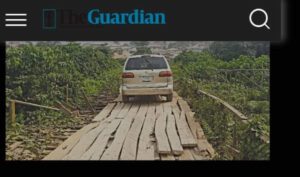
A wooden bridge at Lanre area of Igando that links Ayobo in Alimosho Local Council.
Commuting across Lagos State can be a daunting task hence the reason some residents, commuters and motorists not only avoid routes with potential for traffic gridlocks, they also prefer shortcuts that would lead them to their destinations in good time, and with less stress.
As part of efforts to ease traffic gridlocks and ensure better commuting, the state government has been creating alternative routes on some corridors within the city, linking communities that are separated by large canals or sundry water bodies with bridges.
In areas that are bereft of similar facilities, residents have constructed bridges to link two communities or one section of a community to another, especially in places where the government has failed to do the needful.
And efforts like these dot different parts of the state, just as some of them appear unbefitting of Lagos’ status as a mega smart city. This much can be gleaned from the number of rickety, fee-paying, wooden bridges constructed to serve both vehicular and human traffic.
Igando-Ayobo Wooden Bridges
LOCATED in the Lanre area of Igando, is the Omojowolo Bridge, which links Lanre in Igando, to Ayobo. Both communities are in Alimosho Local Council. Within the neighbourhood is a wooden footbridge, which also links another section of Igando to Ayobo. Even though this pedestrian bridge is longer, it is not as wide as the one located in Lanre, used by vehicles and pedestrians. The use of both bridges attracts fees.
Their crude state not befitting a mega city status notwithstanding, Grace Yomi, a resident of the area said the bridge has been of huge benefit to her because it provides a shortcut to move in and out of the community, especially whenever she needs to connect Igando from her location in Ayobo.
According to her, using the bridge to connect Igando saves her not only money, but time and energy, as she spends more than N500 to connect Igando using the alternative route as against using the bridge, which cost half the amount.
“This bridge was constructed by individuals in the community and they have done a good job. This shows that they are thinking ahead, and also have better thoughts for the residents than the government, which we all voted for,” she said.
Pedestrians pay N50 per usage of both bridges, while cars are charged N200 per trip, and commercial buses N300 per trip. Commercial drivers, however, have an option of either paying per trip, or paying a lump sum for the day.
In explainsing how the bulk payment, which is also called “booking” works, Joseph Chukwuma, a commercial driver said in the lump sum payment that lasts for the day, a motorcyclist is Charged N800, while tri-cyclists pay N1,000; small buses pay N1, 400 and 14-seater buses and the likes are charged N1,700.
He also disclosed that when private cars make use of the bridge, they drivers are charged N200, while each of the occupants part with N50 each.
The driver who frowned at government’s insensitivity for abandoning the people of the area to their fate for about two decades now, lamented that the bridges are not well maintained by the managers despite the charges, as protruding objects including nails often puncture vehicle tyres.
He also alleged that government’s apparent insensitivity was because some persons in government, especially at the local council officials, community leaders and police officers were benefiting from owners and managers of the wooden bridges.
Another resident, Yemisi Adepoju, on her part said using the bridges these days constitute serious danger to commuters as they have become rickety, hence the need for the government to come in and construct proper bridges for the communities.
She also said: “We have heard several times that the government wants to build a bridge for the community, but I am surprised that it has not been constructed to date.”
Credit: Guardian Newspaper












